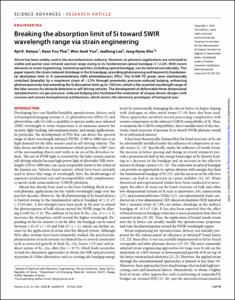Breaking the absorption limit of Si toward SWIR wavelength range via strain engineering
- Title
- Breaking the absorption limit of Si toward SWIR wavelength range via strain engineering
- Author(s)
- Katiyar, Ajit K. ; Thai, Kean You ; Yun, Won Seok ; Lee, JaeDong ; Ahn, Jong-Hyun
- DGIST Authors
- Katiyar, Ajit K. ; Thai, Kean You ; Yun, Won Seok ; Lee, JaeDong ; Ahn, Jong-Hyun
- Issued Date
- 2020-07
- Type
- Article
- Article Type
- Article
- Keywords
- SILICON ; BANDGAP ; PHOTODIODE
- ISSN
- 2375-2548
- Abstract
- Silicon has been widely used in the microelectronics industry. However, its photonic applications are restricted to visible and partial near-infrared spectral range owing to its fundamental optical bandgap (1.12 eV). With recent advances in strain engineering, material properties, including optical bandgap, can be tailored considerably. This paper reports the strain-induced shrinkage in the Si bandgap, providing photosensing well beyond its fundamental absorption limit in Si nanomembrane (NM) photodetectors (PDs). The Si-NM PD pixels were mechanically stretched (biaxially) by a maximum strain of similar to 3.5% through pneumatic pressure-induced bulging, enhancing photoresponsivity and extending the Si absorption limit up to 1550 nm, which is the essential wavelength range of the lidar sensors for obstacle detection in self-driving vehicles. The development of deformable three-dimensional optoelectronics via gas pressure-induced bulging also facilitated the realization of unique device designs with concave and convex hemispherical architectures, which mimics the electronic prototypes of biological eyes.
- Publisher
- American Association for the Advancement of Science
- Related Researcher
-
-
Lee, JaeDong
- Research Interests Theoretical Condensed Matter Physics; Ultrafast Dynamics and Optics; Nonequilibrium Phenomena
-
- Files in This Item:
-
 기타 데이터 / 1.3 MB / Adobe PDF
download
기타 데이터 / 1.3 MB / Adobe PDF
download
- Appears in Collections:
- Department of Physics and Chemistry Light and Matter Theory Laboratory 1. Journal Articles



